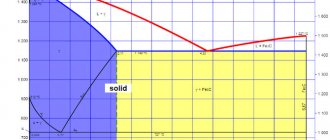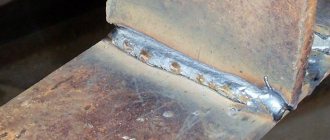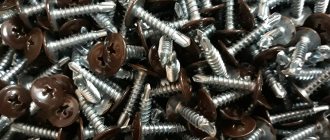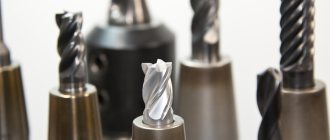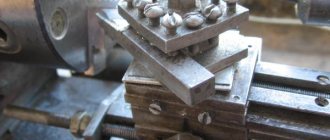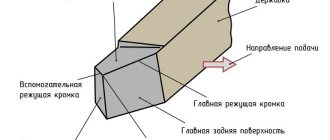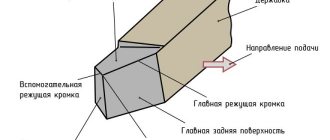Take saws away from humanity and progress will stop. This statement is not a joke. Without a tool capable of cutting wood and metal, concrete and stone, the functioning of industrial enterprises and other areas of commodity production is impossible.
In the household, too, it is impossible to do without saws. Every man has at least one hacksaw, and a good craftsman can find a whole arsenal of “toothed helpers.”
We will look at the most common types of saws to get an idea of their operating capabilities and application features.
It all started with a simple hacksaw
It is this saw that is the ancestor of the family of hand tools designed for wood processing. As soon as the first ingot of iron was smelted, a person had the idea to forge a tool from it for cultivating the earth.
It can be assumed that the ax became second after the hoe. The third was probably a saw with a handle, known to us today as a hacksaw. Over the centuries since its invention, it has acquired numerous “brothers and sisters” performing dozens of different jobs.
The accepted classification divides this type of hand saws into two groups:
- Wood saws;
- Hacksaws for metal.
Depending on the direction of cutting, hand saws for wood are divided into three categories:
- For rip sawing cutting;
- For cross cutting;
- Universal (longitudinal-transverse).
The difference between them is in the shape of the cutting teeth: on a rip saw they are inclined forward, while on a cross saw they are straight.
The universal hacksaw tooth is also inclined forward, but has a special sharpening. It allows you to cut along and across the fibers.
According to their purpose, hand saws are divided into several types:
- Classic hacksaws (transverse or longitudinal cutting);
- Circular saws (for cutting holes);
- Tenon saws (for cutting connecting tenons).
When choosing a hand hacksaw, not only the shape but the size of the teeth plays an important role.
There are three types of incisors:
- Fine tooth – 2.0-2.5 mm (for high-precision sawing and cutting small products);
- Average tooth – 3.0-3.5 mm (for medium-sized parts);
- Large tooth – 4.0-6.0 mm (for rough cutting of timber and logs).
The international classification divides hacksaws not by the height of the teeth, but by their number per 1 inch of cutting blade. This standard has taken root here too, so don’t be surprised if you see the letters PPI or TPI on the instrument label. The number behind them is the number of teeth per inch of length. The larger it is, the finer the tooth (for example, PPI 8 or TPI 14).
Today you can see a modernized type of hacksaws on the market. They are easily distinguished by the gaps cut into the canvas. As a result, the teeth are arranged in groups of 6-7 pieces.
This tool is designed for cutting raw wood. The spaces between the teeth are needed so that wet chips do not clog the cut and can be easily removed during work.
In addition to the usual hand hacksaws, users today are offered an electrified version of the tool. A powerful electric hacksaw can easily cope with a large volume of work on cutting lumber without tiring the owner too much.
Its versatility is achieved by being equipped with saws with different lengths and widths of blades and tooth sizes. This allows you to successfully work not only on wood, but also on plastic and metal. Another name for this tool is a reciprocating saw.
Reciprocating electric hacksaw
The main parameter characterizing the capabilities of electric hacksaws is power. It ranges from 400 to 1600 W. The cutting depth directly depends on it, which ranges from 90 mm for household models to 200 mm for professional models.
Hand tools for metal working are not so diverse. There is only one type of hand saw that can cut this material. Its working body is a wide or narrow blade with small hardened teeth. It is inserted into the bow holder and tightened with a screw.
Circulating
These types of saws are used for sawing fairly hard materials such as wood or plastic.
For different types of circular saws, you can change the cutting angle and depth. They can be used to make longitudinal, transverse, and inclined cuts.
The more teeth there are on the disk, the better the quality of the cut. However, these disks reduce the performance of circular machines. Therefore, carbide-tipped discs are now used.
Compared to a jigsaw, circular saws provide greater precision but are heavier.
Types of circular saws are distinguished depending on the blades used. Thus, carbide-tipped discs are used when it is necessary to cut hard wood, nails, thin metal, and plastic. When using discs without soldering, clean (unlike the previous type) and even cuts are obtained, however, such discs are intended only for soft wood.
Stationary circular saws can be with a closed cast base, lightweight or hybrid. Lightweight circular saws are mainly used at home. The bed can be made of steel and cast iron, but is always open, unlike professional models. It also uses a lightweight suspension. Professional models allow you to make cuts up to 250 mm, and lightweight ones - up to 90 mm. The vibration of the latter types is much higher; the power is supplied from a 220 V network, while the professional ones are powered mainly by 380 V.
Hybrid circulation saws have a closed frame, are low in cost and operate on household power. The maximum workpiece depth for the main saw models does not exceed 75 cm. Hybrid and lightweight circular saws have a power of up to 2 kW, and professional ones - above this value.
Circular saws
The idea of replacing the back-and-forth motion of the cutting blade with a circular one can rightfully be called revolutionary. It arose after the advent of the electric motor and significantly increased the speed and productivity of work.
A typical tool that uses this principle is a circular saw. Its main advantages - mobility and high power - have overshadowed the modest capabilities of a hand hacksaw.
Circular Saw
By design, circular electric saws are divided into geared and gearless. In the first case, the electric motor rotates a gear reducer, on the shaft of which there is a saw blade. The second option is to mount the disk directly on the rotor shaft of the electric motor. Both designs have a mechanism for adjusting the cutting depth and tilt angle.
The advantage of gear mechanisms is the ability to make deeper cuts. Gearless saws have two advantages: lighter weight and affordable price.
The second category of differences consists in the features of the saw blade. It can be active or passive. Everything here is determined by the shape of the tooth. The active disk has teeth bent in the direction of rotation.
In the passive one, they are tilted against the stroke (negative sharpening angle).
Passive discs are indispensable when sawing metal. Active ones are used for wood processing. The teeth of the disc can be tipped with carbide. They make it possible to cut harder materials, but have a negative effect on the cleanliness of the cut.
The operating capabilities of the tool depend on the power of the electric motor (from 0.65 to 2.5 kW). Manufacturers also indicate the maximum depth of cut that can be made using a circular saw (from 25 to 85 mm).
A variation of this power tool is a circular saw, which is mounted on a stationary frame. This solution allows you to cut long and wide materials with high precision.
Some manufacturers offer an interesting compromise - hand-held circular saws that can be turned over and mounted on a table, turning them into a stationary “circular saw”.
When answering the question of what types of saws there are, one cannot fail to mention cross-cutting devices. In this case, the circular saw is mounted on a pendulum arm. A rotating plate with transporter (angular) markings is used as a bed.
Miter saw
The advantages of a miter saw over a circular saw are obvious: you can make perfectly precise cross cuts at any angle. This operation is especially important when joining various wooden parts (platband, plinth, lining, timber).
Tape
The band saw is a continuation of the jigsaw. Its canvas is represented by a belt with teeth, which is closed and driven by an electric motor. Compared to a jigsaw, it provides greater precision and cleanliness of the cut. The cutting depth can be 8-50 cm. Neither a circular saw nor a jigsaw can achieve the maximum cutting depth with a band saw.
The following types of band saws are distinguished:
- According to the material of manufacture - carbon and alloy saws. The latter are characterized by increased wear resistance.
- According to the manufacturing technology and hardening of the teeth, the tapes are classified into saw blades with cut unhardened teeth and cut hardened teeth.
The first saws are inexpensive and allow you to cut wood that has various inclusions. It is logical that low speeds and small amounts of work are used here. Second saws have a high cost, but also high wear resistance.
For shape cutting, 3/8" blades are used, for regular woodworking - 1/2" blades.
There are also band saws for cutting metal, similar in design to a woodworking band saw, but allowing only cross-cutting of rolled steel. This cut can be made at various angles.
Chainsaws
Often when working with wood, it is not the cleanliness and accuracy of the cut that is important, but its depth. This is exactly the problem that a chain saw solves - a powerful device with an electric or gasoline motor, designed for felling forests and cutting firewood.
It has two main interrelated technical parameters:
- Engine power;
- Tire length.
A bar is two flat plates connected to each other with a small gap for installing a saw chain. At one end it has a driven sprocket, and at the other there are cutouts for the tensioning mechanism.
Electric chain saw
The power of electric chain saws ranges from 1.5 to 4 kW. When choosing a device for household work on the site, it is better to choose a power of 1.5 to 2 kW with a saw bar length of 30 to 40 cm. This is quite enough not only for sanitary pruning of the garden, but also for preparing firewood.
If necessary, you can use this tool to dismantle a board, log or beam, although you will not get high quality and precision cutting.
There are two subtypes of electric chain saws:
- With lateral (transverse) engine placement;
- With longitudinal installation of the motor.
The first type is simpler in design and cheaper in price. But the second one is more convenient to use, although it is more expensive due to the introduction of a gearbox into the design.
Chainsaw
The main thing that a chainsaw gives its owner is autonomy. With such a tool you can go into the forest and cut wood there. For such a significant advantage you will have to pay a price: chainsaws are more complex in design than electric ones. This difference is especially noticeable when purchasing a cheap “no-hire” device. Problems with starting, carburetor, rings and spark plugs are frequent companions of such a purchase. Therefore, it is better to purchase a more expensive chainsaw than to lose money when using an economy option.
Electrical
These types of saws are characterized by quiet operation, lightness, absence of gases (unlike chainsaws), and the ability to start in any room if electricity is available. These are their positive qualities, but there are also negative ones. These include, first of all, the need for an electrical network, which is not typical for absolutely any conditions. In addition, these saws can be used at a certain voltage level and their service life is limited to 5 years.
The following types of electric saws are distinguished: circular, circulating, miter saws (characteristics are given below), chain, reciprocating, and electric hacksaw.
Electric chain saws can be used in the garden, preparing firewood. They are longitudinal and transverse.
The reciprocating saw fits tightly to the material being cut. She performs carpentry, joinery and roofing work.
The blade of an electric hacksaw moves along two guides. It is characterized by good safety and cutting accuracy.
Carbide-tipped discs are used for working with hard wood, plastic, and thin metal.
Jigsaw
Circular saws and chain saws cannot replace a device that uses a narrow cutting blade that moves up and down at high frequency.
Thanks to this arrangement of the working body, the jigsaw allows you to quickly and accurately cut curved flat parts. Plywood, ceramics and plastic, OSB and soft metal - all of this can be cut with a good jigsaw with a quality file.
Jigsaw
For each material, manufacturers make special saws that differ both in the inclination of the teeth and in their frequency.
For example, a saw with a large tooth cuts wood better. A blade with a fine toothed notch can handle sheet metal with confidence. We will not give any special recommendations on choosing saws for a jigsaw, since the manufacturer indicates the recommended type of material on each of them.
The main technical parameters of a jigsaw are engine power, saw speed and maximum cutting depth (indicated for different materials).
For household models, these parameters are within the following limits:
- Power from 400 to 900 W;
- Speed (with the possibility of smooth adjustment from 0 to 3000 rpm);
- Cutting depth (wood - 45-80 mm, steel from 4 to 20 mm).
A useful jigsaw option is a laser pointer. It helps to clearly see the direction of the cut when the marking line is hidden under a layer of sawdust. When choosing an electric jigsaw, pay special attention to the attachment in which the file is attached. It should provide the most reliable clamping possible. Otherwise, the file will regularly jump out of its weak “embrace.”
Length, shape and width of the canvas
It is also important to know the dimensions of the blade used to cut a wooden or metal part:
- The length of the blade must be twice the diameter of the products being processed, otherwise the saw will get stuck in the thickness of the material, causing fatigue for the master. Shaped cutting can be done with a hacksaw, the length of which is 150–200 mm. Profiles and small beams are cut with a blade of 250–300 mm, and more difficult tasks are solved with a length of 450–500 mm.
- The standard width of the equipment should be 10–20 mm. If the blade is too narrow, the tool will break when sawing thick workpieces. And wide saws are inconvenient to use.
- The shape often resembles a beveled triangle. Such a universal device can be handled without requiring specialized skills. However, cutting branches of garden plants is allowed with curved hacksaws.

